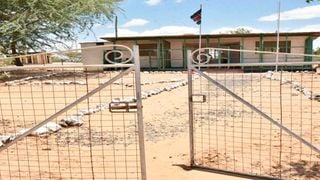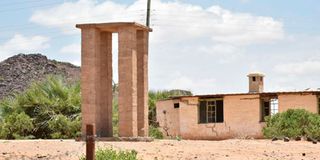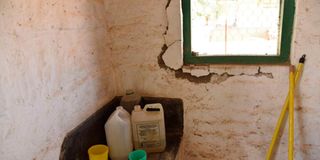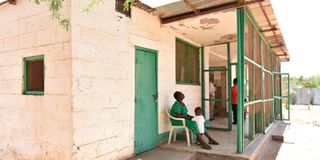
Kenyatta House. Lokitaung is home to the once famous Lokitaung detention camp that housed founding president Mzee Jomo Kenyatta.
| File | Nation Media GroupTurkana
Premium
Lokitaung, the Mau Mau prison in Turkana that Kenya forgot
Some 200 kilometres from Lodwar lies Lokitaung, a sleepy, remote town surrounded by scenic hills. To get there, one can use the Lodwar-Lokichoggio highway before turning right at Gold junction -- a dusty and rocky road. The other route is the Lodwar-Kalokol road.
Lokitaung is home to the once famous Lokitaung detention camp that housed founding president Mzee Jomo Kenyatta, Bildad Kagia, Ramogi Achieng Oneko, Kung'u Karumba, Paul Ngei and Fred Kubai who had been sentenced to seven years’ imprisonment with hard labour for fighting for Kenya’s independence.
Following their arrest in 1952 during the crackdown on the Mau Mau and subsequent prosecution, the six leaders, famously called the Kapenguria Six, were imprisoned at Lokitaung in the northern part of Turkana for seven years.
Almost six decades later, historians and local residents are worried that the site has been abandoned and is at risk of losing its rich history that would otherwise be a source of income to locals.
The camp comprises buildings that include cells, study room, toilets, and houses for prison warders.
At the entrance, there is a building that served as a security checkpoint, and adjacent to it is the house of the senior prison warder who supervised the freedom fighters.

One of the old buildings, referred to as Kenyatta House, which now serve as museum in Lodawar, Turkana County. The house served as a detention camp for five of the Kapenguria six.
Kenyatta’s special cubicle
In the middle of the three-roomed detention camp, is a special cubicle that housed Mzee Kenyatta, who was kept isolated from other prisoners.
A few metres away from the detention camp is a rocky cliff that local residents claim used to be where prisoners were tortured.
Vehicles that were used by colonialists, now rusty shells, lie at the bottom of the cliff.
Some renovations were recently done to the buildings, but historians worry that the work might have erased important pieces of information, and that the place has not been equipped with important literature that would make a tourist’s visit to the site worthwhile.

A room inside Kenyatta House in Lokitaung.
Facelift
The buildings recently got a facelift from the National Museums of Kenya. There are new iron sheets on the roof painted green. The new wooden doors have also been painted green.
The compound is enclosed with a chain-link fence.
The study room, which had its door and windows shuttered, has been repaired. But there is a flipside to these beautiful and important renovations.
For instance, original writings that were scribbled on the walls by the prisoners have been painted over.
Changes questioned
Historians are now questioning the changes and say the lack of historical artefacts used by the freedom fighters has seen the camp lose its importance as a historical site.
The kitchen for the prison warders and a room that served as a record office bear no resemblance to what they were.
"It is not easy for a visitor to get tangible information on the ground. The camp should have all the relevant artefacts and tools that were used and left behind by detainees, warders and colonialists for visual relevance,” Dr Jacob Lolelea, a historian, told the Nation.
He said the houses are sometimes used to accommodate civil servants who are the primary source of information for visitors.
"Besides National Museums of Kenya preserving structures at the site, it should be categorised as a historical site with an on-site curator, where all relevant literature and artefacts must be restored to benefit visitors, who include high school learners, college students and even international scholars,” he added.

Kenyatta House. Lokitaung residents are hopeful that once all artefacts are restored and the site marketed as a tourist destination, the town will have big hotels, and business will boom.
Tourist destination
Lokitaung residents are also hopeful that once all artefacts are restored and the site marketed as a tourist destination, the town will have big hotels, and business will boom.
"Some visitors come only for hours, don't spent a night and never come back, because, despite taking more than five hours on the road, they only have the buildings to see and extremely limited information to take home," said Ms Alice Akeno, a resident.
Ms Akeno said there are people in the villages who worked as cooks for the freedom fighters, and they should be housed at the site and their experiences documented.
Before the renovations, the structures had been abandoned and part of the roof had been blown off by wind. Some doors were falling apart.
Mzee Kenyatta was at Lokitaung until 1959 and was then taken to Lodwar until 1961.
Mzee’s house renovated
In comparison, in Lodwar, Mzee Kenyatta’s one-bedroom house is in good condition after being renovated by the National Museums in 2008, and in 2015 by the Turkana County government ahead of a visit by President Uhuru Kenyatta.
The historian said a Lokitaung Prison museum will boost the town.
"Lokitaung is also strategic because it is close to Nariokotome archaeological site, where Turkana Boy and other early human fossils were discovered. If we marry the rich historical and archeological information, document and store at a museum, Lokitaung can be the city of the cradle of mankind," Dr Lolelea said.
It is possible to restore all the artefacts that are at the National Archives, because at Kapenguria, where the freedom fighters were tried, all relevant artefacts and information is still intact.
From Lokitaung, Mzee Kenyatta, Fred Kubai, Kung’u Karumba, Paul Ngei and Bildad Kaggia were taken to Lodwar,
On April 11, 1961, Mzee Kenyatta was moved to Maralal with his daughter Margaret where he met world press for the first time in eight years.
On August 14, 1961, he was released and taken to his Gatundu home.





